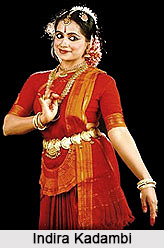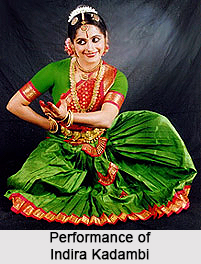 A woman of substance, Indira Kadambi has offered Bharatnatyam that rare personal statement through her grace, style and dedication. Her performance has been applauded far and wide as an "Awe inspiring energy, enchanting dance" . Indira Kadambi started her formal training in Bharatnatyam at the tender age of six under the able guidance of Sri Janardhan Sharma. Later she continued her training under the guidance of Usha Datar .
A woman of substance, Indira Kadambi has offered Bharatnatyam that rare personal statement through her grace, style and dedication. Her performance has been applauded far and wide as an "Awe inspiring energy, enchanting dance" . Indira Kadambi started her formal training in Bharatnatyam at the tender age of six under the able guidance of Sri Janardhan Sharma. Later she continued her training under the guidance of Usha Datar .
Indira Kadambi has a passion to excel. Indira has been regarded as one of the outstanding disciples of Padmabhushan Kalanidhi Narayanan. She has plunged into the refinements of Abhinaya, which is the art of expression. From Kalyanikuttiamma, she had her training in Mohiniattam. She had her training in Carnatic Vocal music from Belakwadi Srinivasa Iyengar and she has learnt Nattuvangam (Cymbals) under Kamala Rani. Under Dr.Kannan Pugazhendi, she took yoga and fitness-training sessions, which further helped her in those agile movements.
Indira Kadambi has performed over two decades. Her performing experience involves several national and international festivals. She has also bagged the honor of sharing the stage with stalwarts like Kelucharan Mahopatra, Birju Maharaj, Amjad Ali Khan, Zakir Hussain, Hariprasad Chaurasia, Jasraj, Vishwamohan Bhat . For performances, lectures and workshops, she has moved around over a great extent to the countries like UK, USA, Germany, France, Holland, and Malaysia. For her outstanding performances, she has received rave reviews in the papers and she has given interviews for the various radios, television networks. Artistry in her performances got more recognition through these press reviews. Indira has been honored as an empanelled artist of the Indian Council for Cultural Relations (ICCR), Government of India.
 Indira Kadambi strongly believes in the classical traditional art form. Her art has maturated as time goes and she has shaped a niche for herself as one of the fantabulous exponents of Bharatanatyam. Being a sensible choreographer, Indira has joined forces with artists from different fields. Her creative approach towards this traditional art form, has given a new dimension to her traditional foundation. In an aesthetic manner she has commingled the forms. But she has kept the content in her works intact as the traditional one. Her works are yet contemporary, which keeps in focus the contemporary awareness. Today, she has been working on conceptualizing and choreographing innovative themes besides choreographing traditional items. Indira Kadambi is endlessly striving to discover different methods to keep the art alive. The main aim of her is to reach to the younger generation while revealing their dance form in the right perspective.
Indira Kadambi strongly believes in the classical traditional art form. Her art has maturated as time goes and she has shaped a niche for herself as one of the fantabulous exponents of Bharatanatyam. Being a sensible choreographer, Indira has joined forces with artists from different fields. Her creative approach towards this traditional art form, has given a new dimension to her traditional foundation. In an aesthetic manner she has commingled the forms. But she has kept the content in her works intact as the traditional one. Her works are yet contemporary, which keeps in focus the contemporary awareness. Today, she has been working on conceptualizing and choreographing innovative themes besides choreographing traditional items. Indira Kadambi is endlessly striving to discover different methods to keep the art alive. The main aim of her is to reach to the younger generation while revealing their dance form in the right perspective.
At the `Ambalam`, Center for Performing Arts, she is the Artistic Director. In India and abroad she has conducted several training programmes and trained dedicated students. Some of her students have blossomed forth into talented performers. For intensive training sessions, students and teachers from abroad visit the Centre every year. Abhinaya, the art of expression and Nattuvangam, the art of playing cymbals are the field where she specializes. Around the world, she has demonstrated several lectures and her lecture demonstrations have also been well received.
Some of her noteworthy performances includes, `Varsha Rithu`; `The Divine Flute -Vamshi`, `Hasya` -; `Purusha Parinaam` - `; `Sadashiva Darisanam` -; `Ashta Naayakiyarin Ishta Murugan`- `Manonmaneeyam` - `A Tamil epic written by the poet Sundaram Pillai in 1892.This work is based on the legend-The Secret Way, written by The Rt.Hon.Lord Lytton`; `Jugalbandhi` - `A memorable programme with Mohiniattam artist Smitha Rajan`; `Kavya-Chitra-Geeta-Nritya`- ``Gita Govindam` - `The immortal epic of love between Radha and Krishna carries beautiful imagery of surpassing beauty, startling eroticism and transcendental spirituality`; `Harsha` - `A Special feature presented for the National Conference on the Sanskrit playwrights-Bangalore`.
For her stupendous contribution in the field of Bharatanatyam and Mohiniattam dance, she has been conferred many awards. In the year 2002, she has been conferred the `Senior Dancer Award` by Natyarangam, Narada Gana Sabha, at Chennai. Aryabhatta Cultural Association in the year 1996 conferred the Natya Shanthala award at Bangalore.
The South Central Zone Cultural Centre, Government of India, has awarded the `Best Dancer Award` Indira in the 1993. From the year 1984 to 1989, she has won several prizes at state and national level intercollegiate dance competitions.
The Hindu once stated on her performances, `Danceuse in complete control" . Extremely lyrical and precise Indira Kadambi`s dance recitals are therefore capable of transporting the viewer to the utopian world of sheer joy.



















